Moon of Honey
There are people who do their laundry a few hours before they remember they have a flight, and there are people who pack six days in advance. These two people marry each other. I read this meme and sent it to my husband. I am usually the planner of bike tours and trips — the one who packs early and packs snacks, extra layers, and gifts for the people we visit. My husband, Tom, flies by the seat of his pants. He makes friends with bartenders, taxi drivers, and seatmates. He never knows where his headlamp is, and he is my favorite person who still drives me crazy.
Planning a wedding and a subsequent honeymoon is sort of nuts, yet somehow this tradition prevails. You plan the biggest, most important celebration of your life, invite all those you know and love, then you get on a plane or in a car, and take an elaborate vacation. It’s just you and the person you just committed to for life. It’s too much all at once, yet we still do it.
I pondered the impossibility of effectively planning both a wedding and a honeymoon as I wiped gravel from my cheek, the equivalent of marks from the bedsheets after a deep sleep. I had muttered, “Can you watch the bikes,” to my husband before curling up on the ground and succumbing to exhaustion on a plaza in Lisbon. Months previously, at my insistence, we had taken one single evening to plot our honeymoon bike tour on a paper map with a highlighter. The map was so zoomed out that it barely showed the roads we wanted to take. Once we arrived in Europe, we realized our phones were almost useless, since we hadn’t quite gotten the knack of offline maps. Hmmm. Well. We sat in the mid-morning sun of the plaza, and Tom looked at me expectantly, his salt and pepper eyebrows raised as if they were asking me, “What’s the plan?” Like I knew. I was frustrated with our lack of preparedness and tried to figure out the date and the time.
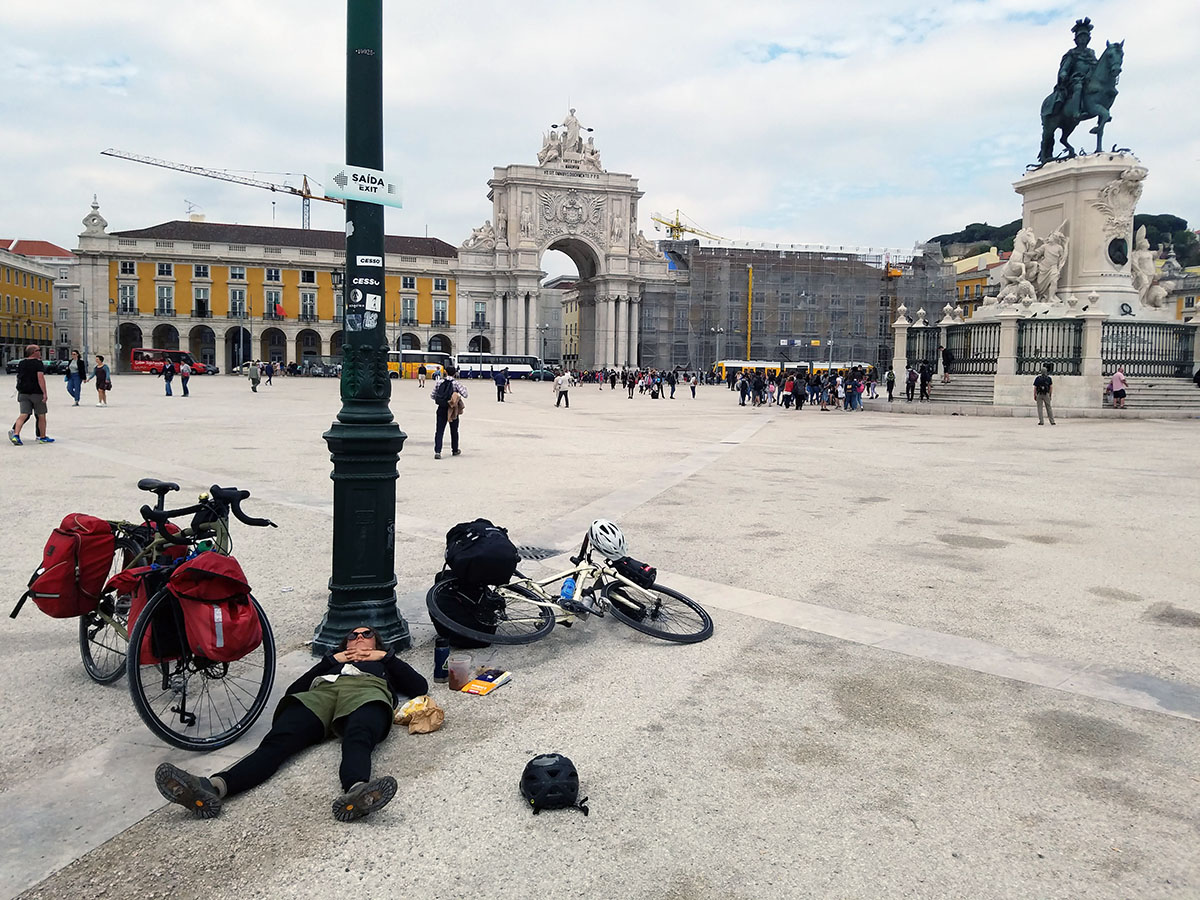
Our wedding festivities had lasted four sleepless nights, all of them magical and glowing, as weddings tend to be. The band played into the wee hours of the morning, while friends and family from far and wide got rowdy on the grass dancefloor. There might have been some midnight nude swims in a quarry but that’s another story. After all the celebrating, we taped our panniers together to count as one piece of luggage and took a red-eye flight across five time zones. Assembling our bikes in the Lisbon airport, we argued over nothing, and waves of jet lag washed over our leaden bones. My brain felt like a Salvador Dali painting.
Amidst the chaos and busy months leading up to the wedding, we hadn’t made many plans for our honeymoon. In fact, we made zero arrangements for our Portuguese splashdown. After a fortuitous rendezvous with a quirky British ex-pat who biked with us from the airport to downtown, we got confused on narrow one-way cobblestone streets. After my “nap” in the plaza, we eventually found a hotel that let us check in early. Sweat broke out on my forehead as elevator doors closed on my rear wheel. We then figured out how to strategically take the tiny elevator one at a time. We stood each bicycle up on the rear wheel, all four panniers attached, waving goodbye to each other for a brief moment. Our room had two twin beds, quite comical for the first night of our honeymoon, Lua de Mel in Portuguese or Luna de Miel in Spanish. Moon of Honey. It didn’t feel like something that magical at the moment though. Shoving the beds together, we succumbed to jet lag and slept. when we awoke, dusk was just approaching, now near 10 PM. I fretted that restaurants wouldn’t be open for dinner this late while Tom said calmly, “I’m sure we’ll find something.”
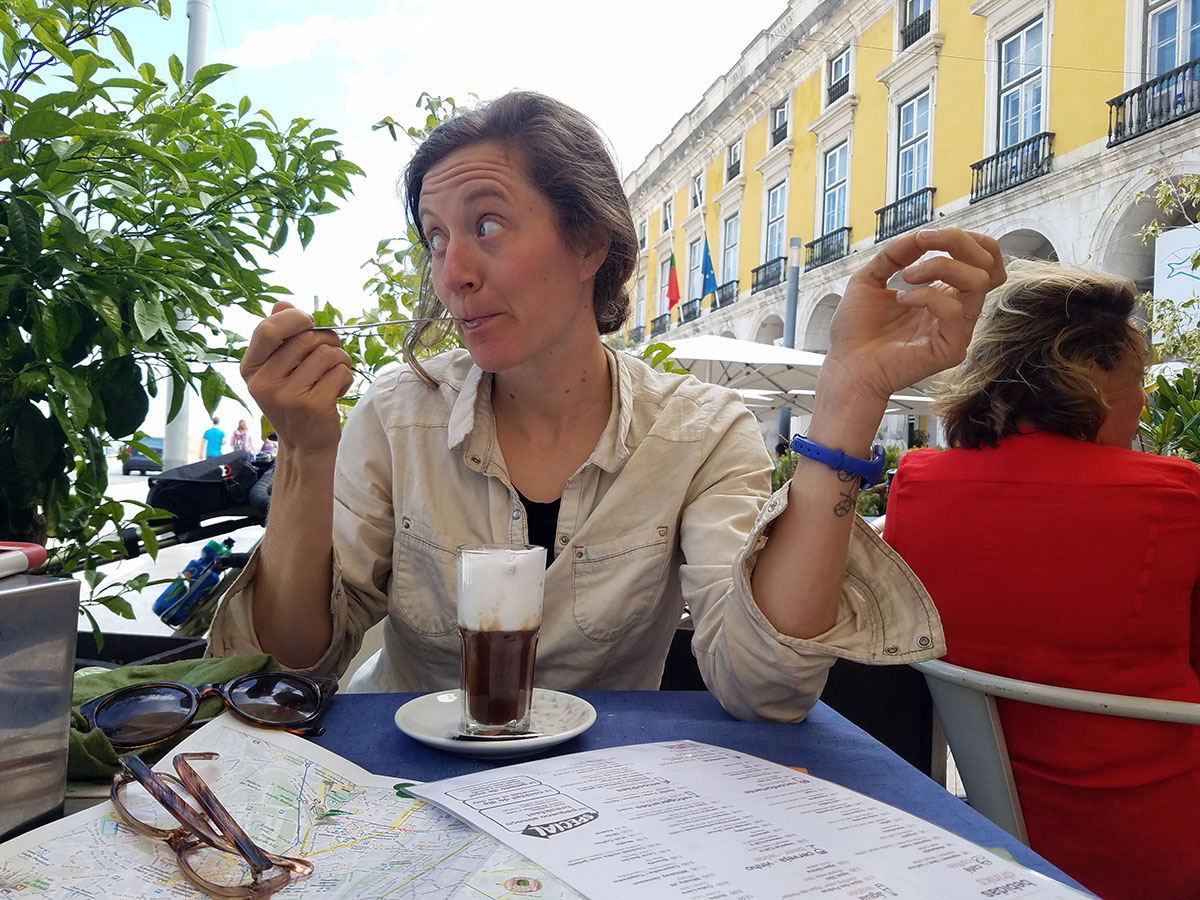
We walked the lantern-lit cobblestone streets hand-in-hand, past gorgeous architecture, painted tile, fountains, and intricate stonework. The sea rolled in the background and boats of various sizes took shelter in the harbor. The restaurant was not only open, but it was also half full. Sea bass, octopus, bread, olives, and custard made my eyes go wide with each bite. At Tom’s insistence, our waitress pulled up a chair and chatted with us, giving us a glimpse of Lisbon, where she had lived her whole life.
Following our paper map, directions from locals, and tenuous offline maps on our phones, we headed south with a rough idea of hitting Sevilla before turning north to Madrid. Leaving Lisbon, we mistimed a ferry and had to wait hours for the next one. Usually waiting for hours would make me a bit upset while Tom wandered around with a smile on his face. This time I decided to let go of my type-A tendencies and haltingly, slightly stubbornly, go with the flow. Before I knew it, it was time to board the ferry.
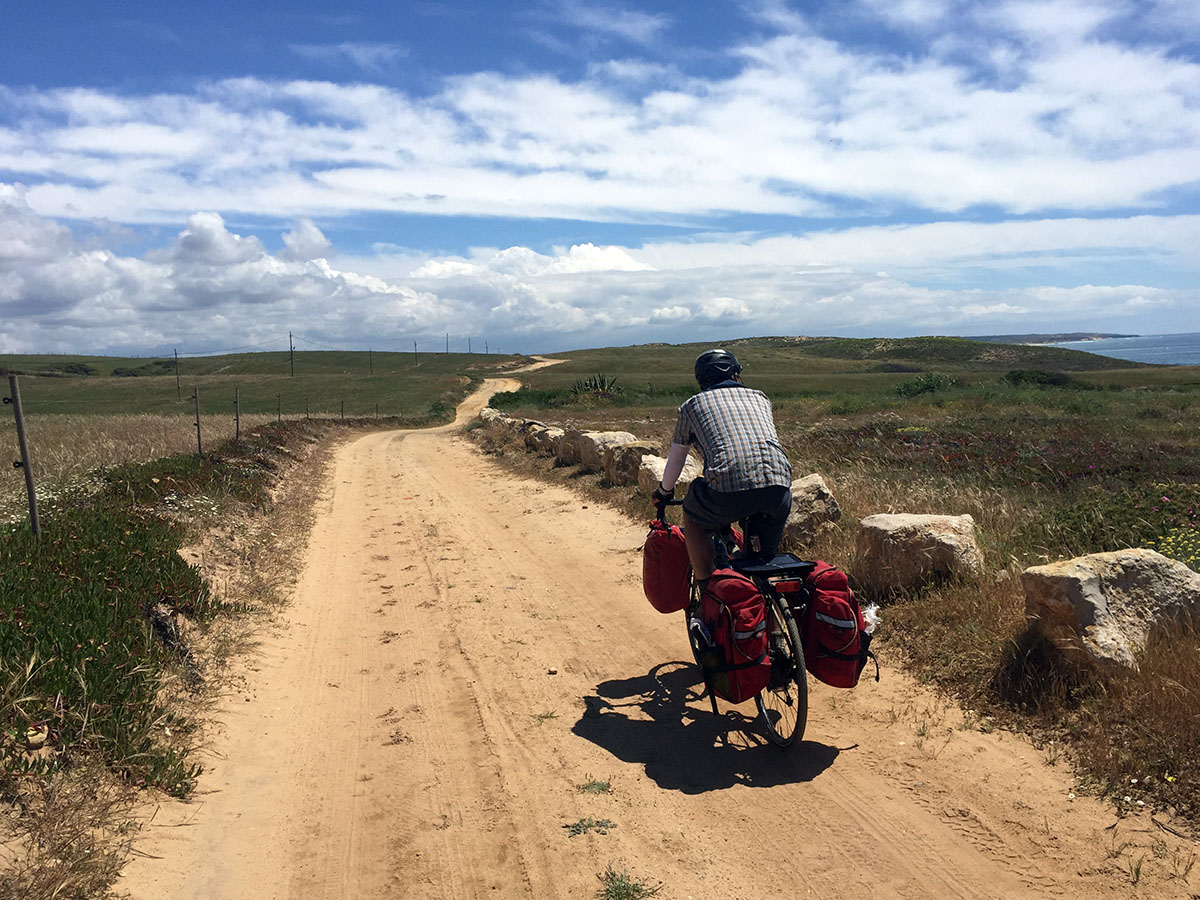
The sinuous coastal road sat above shrub-covered slopes, and navy blue water swelled offshore. Countless flowers lined the road — snapdragons, Corydalis, rock-roses, and daisies — yellow, pink, and purple popping out from each bend in the road. The road descended steeply to the beach, and there was an unexpected lone restaurant where we bought a bottle of wine to supplement our meager dinner. The owner opened the bottle for us since we had neglected to bring the necessary tool. The far end of the beach looked like a good spot to set up camp, and we felt good about our first day of riding … until we realized we’d forgotten to buy fuel for our stove and only had rice for dinner. We noticed a man further down the beach. Did he have a small fire? I approached apprehensively.
Dinis turned out to be a chatty, friendly adventure cyclist from Russia, and we cooked our rice on the coals of his fire while he roasted sausages. Wanting to share the wine but having no cups, Dinis procured a wine glass, actually made of glass, from his pannier bag, claiming that it was simply wrong to drink wine from anything else. The three of us told stories and laughed until our eyelids were heavy and a light drizzle started.
Despite my unease at our lack of plans, the rest of our trip went something like this. Through Setúbal and another ferry delay, we made friends with Spanish traveling cyclists with super light setups and got chatty with many cafe owners, as we fueled our new love of espresso. Ostriches, vineyards, and turquoise waters flanked our route as tan dirt road roads linked small towns together. Everything was working out well enough, and we even went to a stranger’s wedding party one evening where they loudly toasted and congratulated us on our recent nuptials.
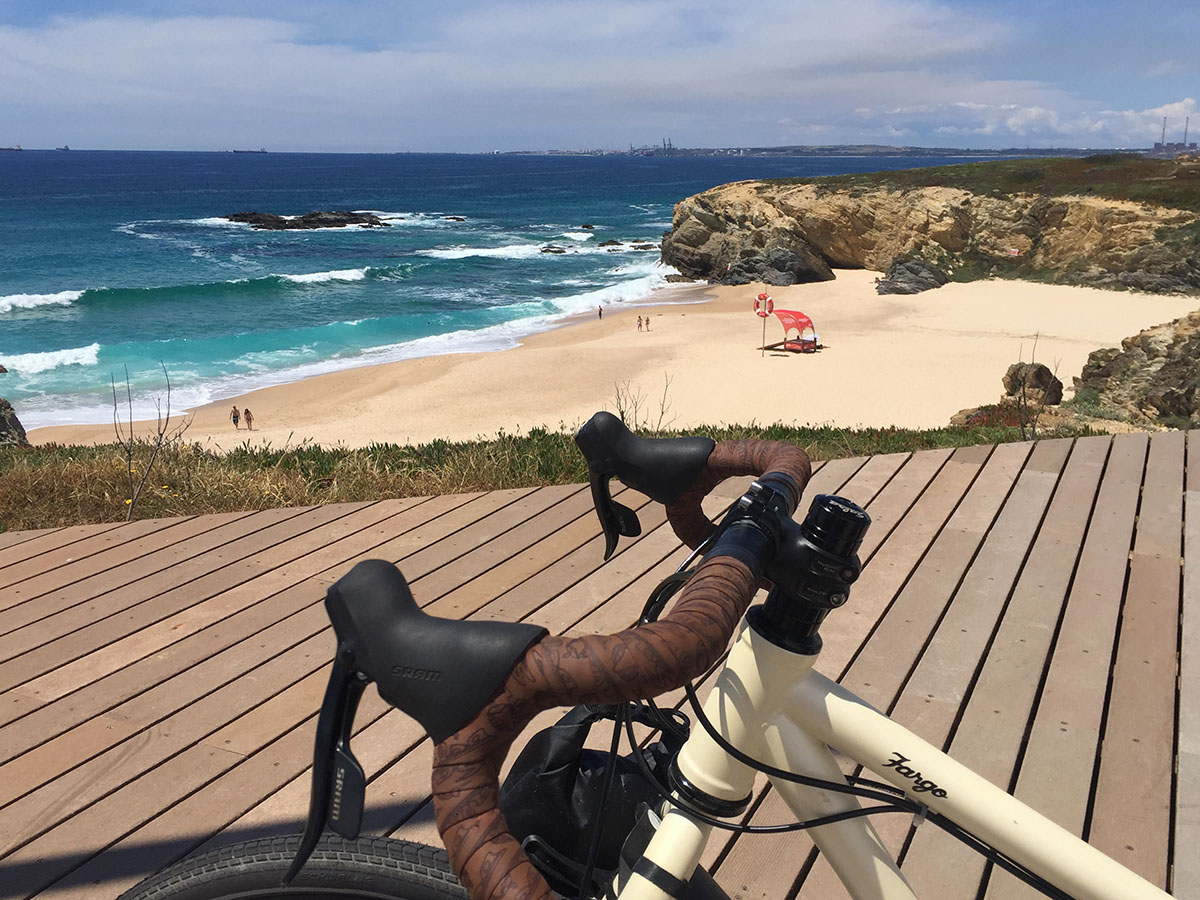
Continuing down the coast to Aljezur, we camped on the beach and between industrial agriculture areas. Sand permeated every corner of our gear, and we opted for a hotel after four nights of camping. They didn’t believe that we, dirty cyclists, were there to check in. We rarely made the miles planned for each day, and every day was a mental exercise in letting go of these expectations, agendas, and the feeling of satisfaction that comes from a goal met. Instead, we bumbled along, and somewhere in the middle of our trip, ended up on the highway for two days of exhaust fumes, horrendous bridges, bent steel guard rails, and blurs of traffic. When we tried to detour, there were only grassy roads or dead ends. I learned to laugh about it.
We pedaled away from the Portuguese coast to the mountains, and a small group of Portuguese retirees invited us to join them for lunch in the tiny hilltop town of Marmelete. Moda caps with short bills shaded their weather-worn faces, and our meal turned into a two-hour, two-beer lunch. Fried quail and olives were served as one man was teased for his special attachment to his dachshund who sat at the table with us; another proudly showed us his ingenious trap for snails, which are eaten seasonally.
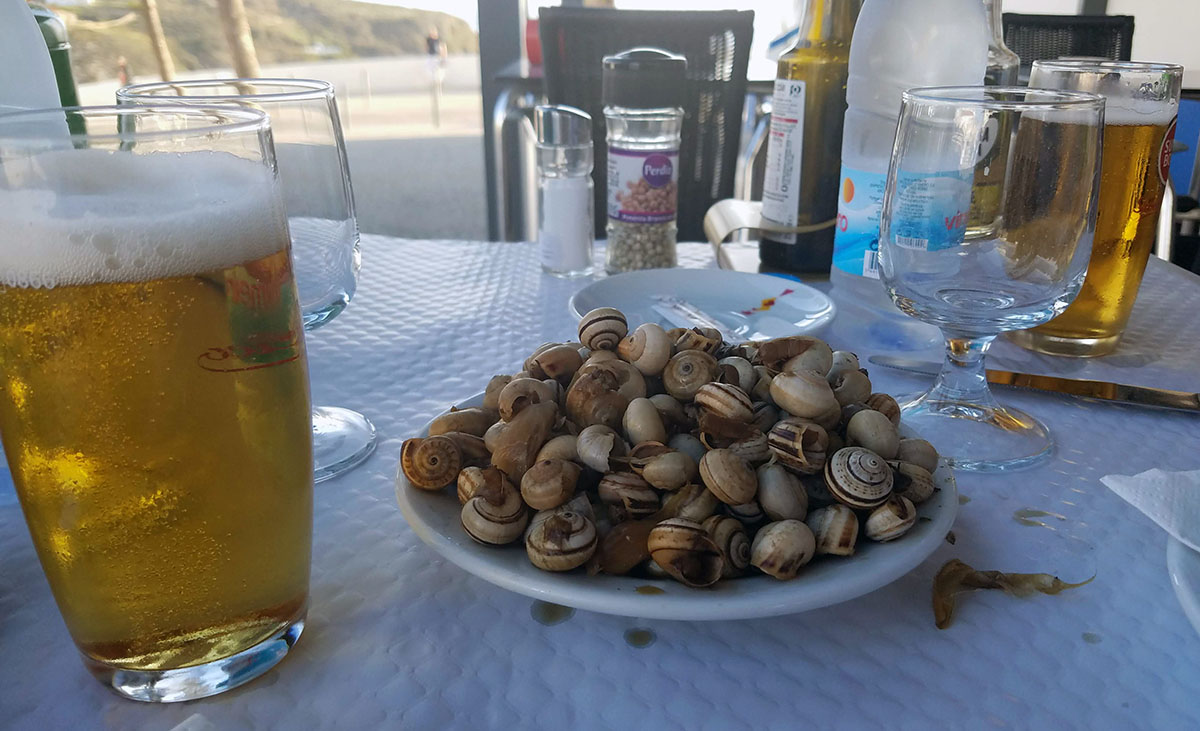
From there we pedaled along smooth rolling hills to the east, camping in olive groves and orchards en route to Tavira. We listened to someone’s radio play opera music all night and cursed the incessant barking of dogs. Old men and women worked in their gardens at all times of day and night, always wearing collared shirts, skirts, and sweaters and never in a particular hurry. Their calm was infectious, to me at least. I think Tom had already gotten the memo.
We took the ferry into Spain, and the landscape immediately became drier. The culture and agricultural processes were more modern, yet still retained historic charm. We kept stumbling into towns where we had no idea what to expect. Tom kept saying, “Wow! Who knew this place was going to be so great?” As we strolled down another cobblestone street after yet another 10:00 PM dinner. In Huelva, I thought he might stay there forever when he saw a row of cured ham legs ready to be sliced into prosciutto. These towns were never planned stops, just little jewel boxes that opened themselves with a key whimsy.
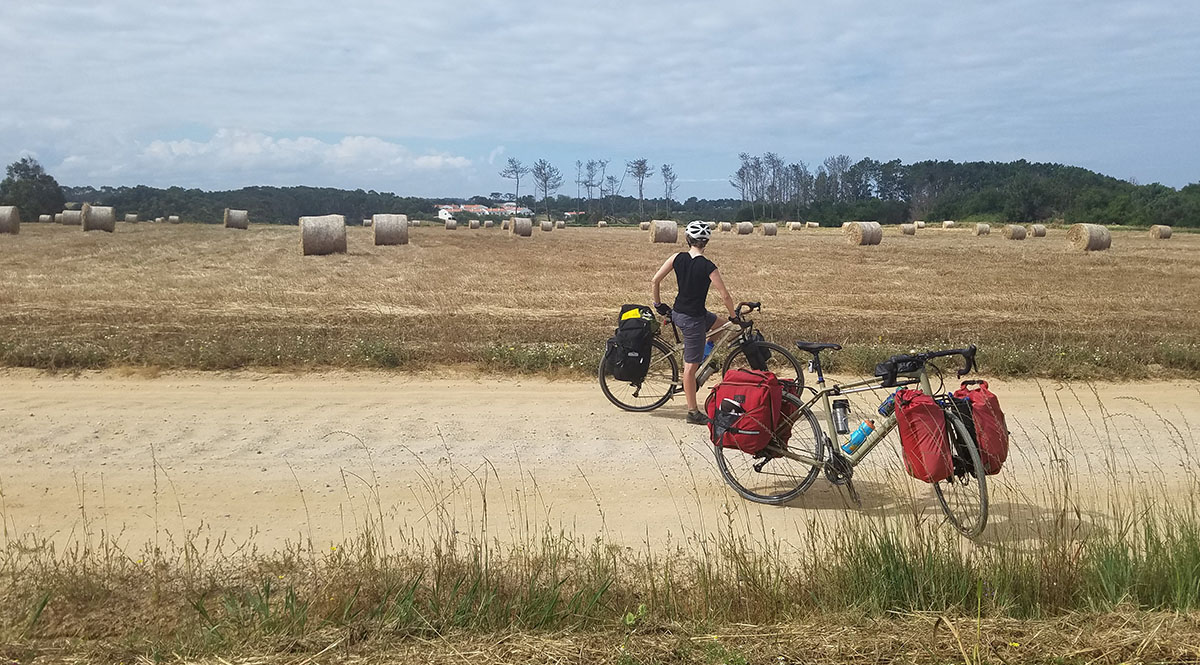
Our jet lag morphed to adopt the Portuguese and Spanish schedule, and we marveled at how crowded a plaza would be at 10:30 PM on a Wednesday. Kids ran around while lovers, including ourselves, gazed at each other over glasses of wine. In true honeymoon fashion, we slept in, and I learned a new level of calmness. From Huelva we pedaled to Seville, Alanis, Helechel, and Telaveira de la Reina. When we camped, we had simple meals of bread, sardines, and wine but when we went through towns, we sampled all the tapas. These small dishes ranged from anchovies, olives, and seared tuna to carpaccio and steak tartare, all with a glass of wine or beer. We tried new and exciting dishes of pheasant, morcilla (blood sausage with pine nuts, a recipe that differs by region), and venison. Towering golden oaks took us towards a well-earned rest day in Toledo, where old world charm exuded from every door that required a skeleton key.
After our final night of camping, we woke in the hills outside Madrid to Spanish police officers politely informing us that camping is illegal in Spain. Hmmm. Oops. However, being homeless is not illegal so sleeping outside is okay but not in a tent. Apparently, the real risk is with stoves and the high threat of wildfire in extremely dry areas, which is most of the country, especially in the summer. We never did use our stove. We never did buy fuel. Instead, we became accustomed to camp meals of bread, cheese, and sardines or cured meat. Tom carried our useless pot and sack of rice the whole trip.
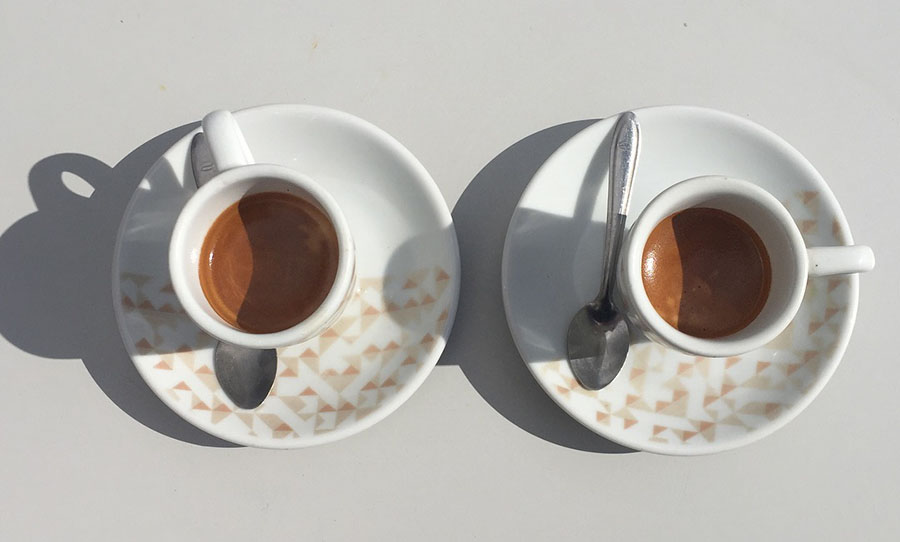
This trip taught me a lot about international bike touring and about my husband, marriage in general, and how to keep rolling despite plans, change of plans, or lack thereof. A little planning, of course, is good, especially in regards to safety. But by planning too much, I might not leave enough room for the wonderful and whimsical things that happen on bike tours, or in life in general. I’ve come back to these lessons a lot over the past two years as life and travel have gone topsy-turvy for all of us. I’ve learned to let go, and that if you just keep pedaling, the wheels will roll in the direction they need to go.
Our final destination was Tres Cantos, a suburb north of Madrid. We improvised a stunning back route to avoid a huge swath of private land that spreads out around the capital city. We stayed with an old friend of mine, Laura, who was recently engaged to a Spaniard, Gonzalo. We ended our three-week gallivant around Portugal and Spain here, and despite our different ways of doing things, my husband and I were more in love than ever; the golden hours of the past weeks lit us up from the inside. We gave Laura and Gonzalo plenty of advice on planning a wedding, and not planning a honeymoon.
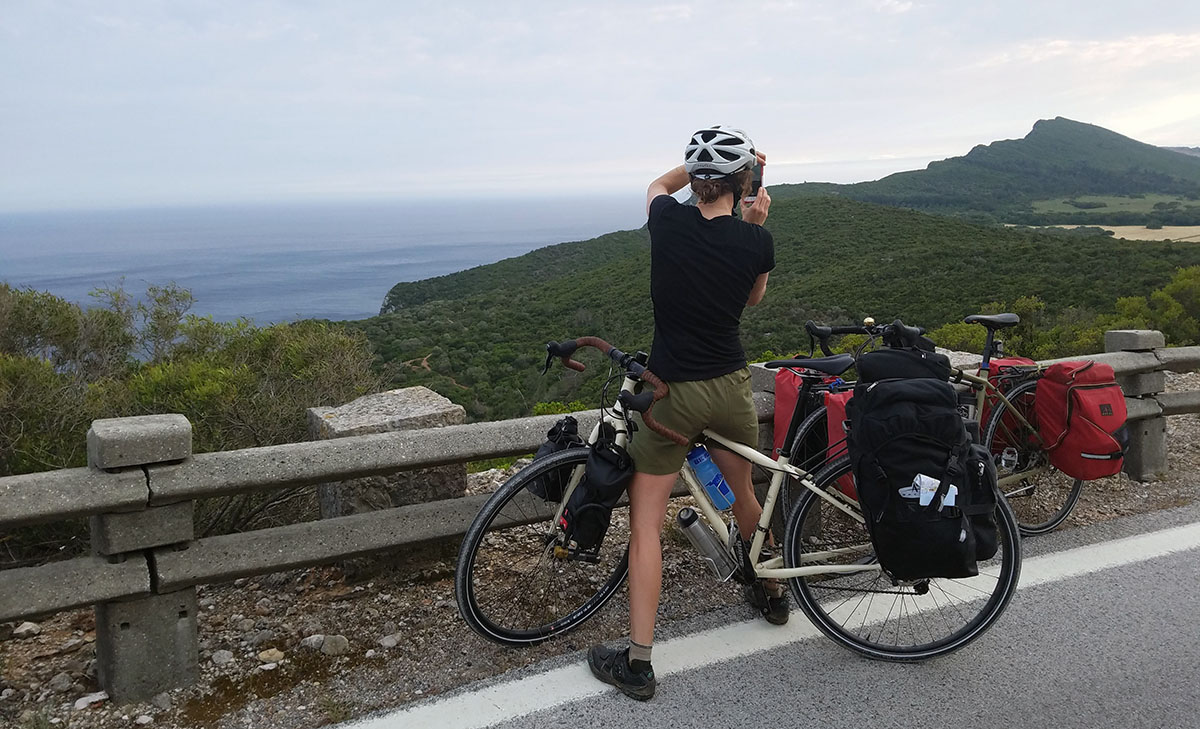
Nuts and Bolts
Since I would not recommend following our route precisely, there’s no GPX track. But I would recommend using a good offline mapping app on your phone or GPS. MapOut works really well for iPhones, and you can create your route as you go since it is phone-based. RidewithGPS, Komoot, and maps.me also have good offline options. Test your offline map to make sure it is downloaded all the way. Strava heat maps can also inform good, low-traffic routes. We took touring bikes with wide road tires. Most road surfaces are smooth asphalt, with some nice fine gravel once you get off the main thoroughfare. The hills in the south were gradual enough that any bike will do, though the easier gears with a loaded bike are always nice. The north of Spain is an entirely different story — those mountains are steep!
As mentioned, camping is technically illegal in Spain, though sleeping outside is not. So you might want to consider a bivvy sack and going stoveless.
When to Go
Spring (April/May) is ideal and has wildflowers! Fall (September/November) is also a nice time to visit Portugal and Spain. Seasons differ from north to south so it depends on your route. Summers are hot and dry in most of Spain and away from the coast in Portugal, which means that water is unlikely higher up into the mountains but resupply points are fairly frequent. We found gourmet, cheap food in small towns everywhere. Portugal’s coast can be rainy and somewhat chilly any time of year but inland, a Mediterranean climate dominates, with wet winters and dry summers. Trail and road conditions depend on your route, the season, and local construction. As always, avoid high-trafficked roads, where shoulders rarely exist and be mindful of private land and hunting reserves, which are common but usually marked with small signs that read “coto de caza.”


